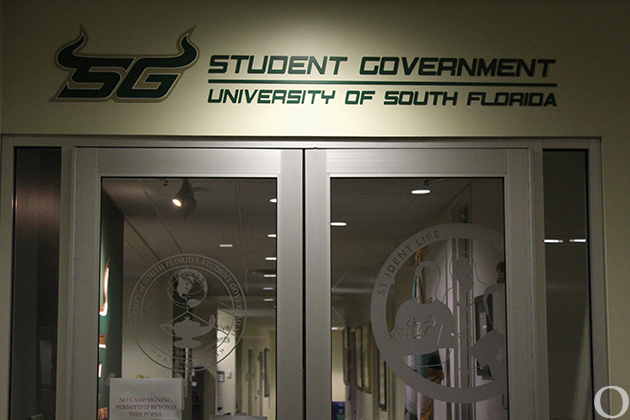USF joins Big East
Months of speculation finally came to an end Tuesday when USF was officially extended, and subsequently accepted, an invitation to join the Big East Conference beginning in 2005.
In a pep-rally style atmosphere, complete with cheerleaders, the Sun Dolls, athletes and Rocky the Bull, USF president Judy Genshaft and Athletic Director Lee Roy Selmon addressed the amassed media on their collective decision to leave Conference USA for the re-established Big East.
“We know it was a long process, and they were very deliberate about it,” Selmon said. “But I’m thankful that they saw that the University of South Florida was a perfect fit for them. We know that we’re a perfect fit for them as well, across the board.”
Entering the Big East along with USF were C-USA schools Louisville and Cincinnati, as all-sports members, and Marquette and DePaul, as non-football members. The move was to counter the expansion of the Atlantic Coast Conference, which added Miami, Virginia Tech and Boston College from the Big East.
Following the announcement to add the five new schools, Big East commissioner Mike Tranghese acknowledged the tumultuous last few months of the major conference realignments.
“It’s been a long, long process, but I don’t know if I can adequately express how we are so pleased to finally have it ended,” Tranghese said. “As I stand here before you today, I can’t express how excited we are about our future and, in particular, the five new schools that our presidents unanimously voted to extend invitations to.”
However, USF wasn’t originally expected to be invited. The rumors originally began after Boston College decided to leave for the ACC, which left the Big East searching for an eighth football member to fulfill NCAA Division I-A conference requirements.
And the Big East spent plenty of time analyzing USF before ultimately deciding to extend the invitation.
“We looked at the institution first,” Tranghese said. “We wanted to make certain that our schools were a comfortable fit. I think as we began to look at it, the thing that attracted us about South Florida is I think they have enormous potential — not only because they are in Florida; I think it’s their commitment athletically; it’s their commitment institutionally.
“I think for all those reasons, that’s what ultimately led to our presidents extending the invitation to USF.”
USF didn’t have so much trouble in deciding to accept the invitation.
“If you compare our strategic plan and the goals we have set for ourselves with the profiles of these universities, you will see that they are institutions that share our values and commitments to excellence in academics as well as athletics,” Genshaft said.
To compensate for the five lost schools, C-USA announced Tuesday they would add Marshall, Rice, Southern Methodist University, Tulsa and UCF for the 2005 season.
Now all that seems left is the fees that USF pays to exit C-USA and enter the Big East, and that may be the biggest hurdle left for USF.
It previously had been reported that the exit fee from C-USA is in the range of $500,000, while the entrance fee into the Big East is undetermined. However, Genshaft provided a few possible solutions.
“Commissioner Tranghese will be working with us on our entrance fee,” Genshaft said. “What we understand is that the revenue we generate will be used to pay off our entrance fee.”
Tranghese said the Big East will not help pay the exit fees for any school leaving for the conference.
“What the five members are doing with Conference USA is taking place amongst their presidents, and we’re not involved in it at all,” he said.
Genshaft stated she would not use any state money, nor any money designated for academics, toward any athletic fees. One possible solution to generate more revenue is an increase in student fees, which was being discussed even before the possible conference shift.
“We have an additional athletic fee that we talked to the students about,” Genshaft said. “Even before the Big East, it was on the horizon.”
The proposed increase was 25 cents, and Genshaft said she didn’t foresee any extra fees beyond those already discussed.
Student body president Omar Khan also said he would be opposed to raising any type of student fees, barring an extreme circumstance.
“I’m always against raising student fees, but of course, it depends on the reason,” Khan said. “Before any fee of any type is increased, I will do a thorough investigation to make sure that is the right move for the students.”
Among other rumors is that Boston College may seek entrance into the ACC beginning next season, to coincide with Miami and Virginia Tech’s entrance. Should that happen, USF could possibly seek to enter the Big East next season.
“We would like to move in as soon as we could,” Genshaft said. “We would consider it, but we’d have to consider it with our community members and our foundation, whether or not they’d be willing to help us out.”
Tranghese said he doesn’t want to interfere with any other conference’s decision, stating that the Big East presidents would not insert any other conference’s business. However, Tranghese said he would listen to suggestions, if any were presented.
“I mean, if C-USA came to us and said, ‘would you consider taking members in earlier?’ We would take it to our presidents immediately and discuss it.”
The bottom line is, despite all the uncertainties that may remain, the simple fact is that USF is headed for a new conference.
“So get ready Big East,” Genshaft said. “There are new colors in the conference — green and gold. And a bull is coming today.”






